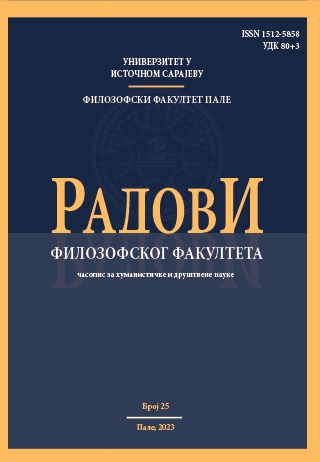РАШЧЛАЊАВАЊЕ СУБОРДИНИРАНИХ КОНСТРУКЦИЈА У РОМАНУ О ЛОНДОНУ МИЛОША ЦРЊАНСКОГ И ЊЕГОВОМ ПРЕВОДУ НА ЕНГЛЕСКИ ЈЕЗИК
DISSECTING SUBORDINATE STRUCTURES IN A NOVEL OF LONDON BY MILOŠ CRNJANSKI AND ITS ENGLISH TRANSLATION
Author(s): Aleksandra D. Rakić, Ana Lj. VučićevićSubject(s): Morphology, Syntax, Serbian Literature, Translation Studies
Published by: Универзитет у Источном Сарајеву, Филозофски факултет Пале
Keywords: expressive syntax; intonation phrase; subordinate structures; punctuation; sentence fragments; Miloš Crnjanski; A Novel of London; translation equivalents;
Summary/Abstract: This paper is a small-scale study of subordinate structures as intonation phrases in A Novel of London by Miloš Crnjanski. The study also addresses the corresponding constructions in the English translation of the novel. We differentiated between two respective types of subordinate structures: intonation phrases obtained by inserting commas and intonation phrases that are actually sentence fragments. We also examined morphosyntactic features of the examples selected both from the original and its translation, adding some comments with regard to the stylistic effects particular intonation phrases may have in reading. Speaking from the perspective of the Serbian morphosyntax, in our corpus comma-separated intonation phrases are predominantly adverbials, substantive phrases with a congruent attribute, syntactically ambiguous prepositional-case constructions, (antecedents) and dependent clauses. Full stop-separated intonation phrases are (coordinated) adverbials, adnominals, objects and dependent clauses. Translation analysis has shown that comma-separated intonation phrases were not consistently translated, at least not as much as sentence fragments. Taking account of the formal and stylistic options in the target language as well as translator’s comments regarding supremacy of readability in English, we interpreted inconsistencies in translation as a matter of translator’s choice. In those terms, we suggested some options that could contribute to greater punctuation and stylistic correspondence between the original and translated version. Finally, we offered some ideas for further contributions in the research of Crnjanski’s opus in this particular domain.
Journal: Радови Филозофског факултета (часопис за хуманистичке и друштвене науке)
- Issue Year: 2023
- Issue No: 25
- Page Range: 95-114
- Page Count: 20
- Language: Serbian

